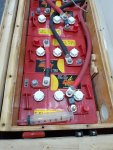Photobug
Well-known member
Those are great, I am using one on my current build. It saved some pain when i dropped the wrench across the battery terminals before. They also make a double MRBF if you wanted to run two sized wires off the battery.Looking at fuses, I'm going to save some space with a Blue Sea 300A MRBF terminal fuse on a single terminal fuse block. The max discharge rate of the battery is 320A, so this will function as a last ditch protective measure, with a little headroom.
View attachment 545480


